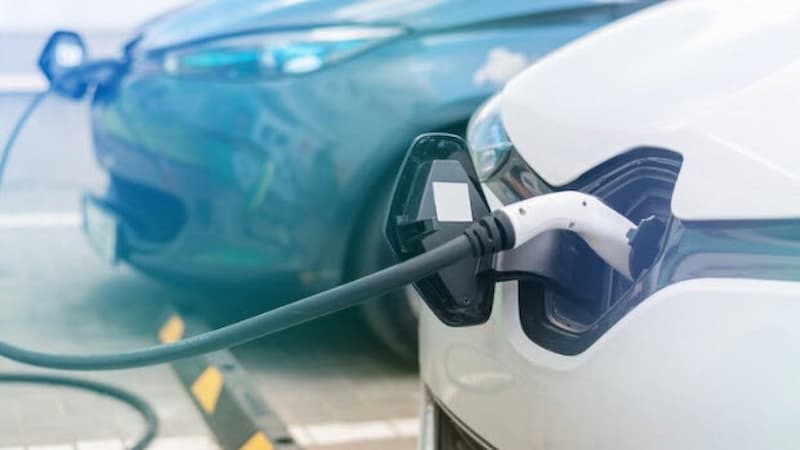(Jerry Korth) America may be headed for a new type of energy crisis. While fracking technology still gives us relative energy independence, there is a distinct possibility that an electricity energy crisis awaits us. What if the demand for electricity significantly exceeds the supply over the next decade? We’d have soaring prices and rolling brownouts. That crisis could easily be triggered by the electric vehicles (EVs) Biden’s administration is pushing.
Related Does Bitcoin Use “Too Much” Electricity?
by Jerry Korth, February 8th, 2022
By his Executive Order and an associated Action Plan, Biden’s administration calls for 50% of all new vehicles sold in America by 2030 to be EVs. That means an additional 50 million new EVs on the road in the next nine years, all in an effort to lower Green House Gas (GHG) emissions, namely CO2.
On December 13, 2021, the administration announced its plan to spend $7.5 billion to construct 500,000 EV charging stations throughout the US. The plan’s funding comes from the $1.2 trillion Infrastructure & Jobs Act Biden signed on November 15, 2021.
Then, on January 20, President Biden signed Executive Order 13990—Executive Order on Protecting Public Health and the Environment and Restoring Science to Tackle the Climate Crisis. This EO includes a wide range of environmental policies including vehicle fuel economy standards. The scariest of those policies is a set of new regulations from the EPA called SAFE, which stands for The Safer Affordable Fuel Efficient (SAFE) Vehicles Final Rule for Model Years 2021-2026:
The National Highway Traffic Safety Administration (NHTSA) and the Environmental Protection Agency (EPA) finalize updated Corporate Average Fuel Economy (CAFE) and greenhouse gas emissions standards for passenger cars and light trucks and establish new standards, covering model years 2021 through 2026.
Fun Fact: These standards, imposed on car manufacturers, set the minimum average fuel economy limit (i.e., 40 miles per gallon) for their entire fleet of vehicles. A gas-powered fleet alone cannot meet these standards. Instead, car companies must sell more EVs to increase their fleet-wide average fuel economy. One way is to hawk EVs as more fuel-efficient.
On the EPA-mandated sticker on new EVs, you’ll see a fuel economy designation called MPGe (Miles Per Gallon equivalent). It’s usually greater than 100, making unwary consumers believe the vehicle is several times more fuel-efficient than a comparable gas guzzler. However, EVs are not really several times more fuel-efficient (but that’s a topic for another day).
Americans bought or leased about 15 million new cars and light trucks in 2021 and that number is forecasted to grow to 17 million by 2030. Assuming a ramp-up in EV sales from 2.3 million in 2021 to 8.5 million in 2030 (50% of 17 million), there would be 50 million more new EVs plugged into our electrical grid. The big question, then, is where vast amounts of so-called “clean energy” come from to charge all those EVs and what will it cost consumers.
Fun Fact: The current average price of electricity that residential consumers pay is $.14 per kilowatt-hour (kWh), although it varies from $.09 to $.23 per kWh based upon local supply and demand. Imagine if the price of electricity in your area increased by 50%. Or worse, imagine there is no electricity to heat and cool your home or…charge your brand-new EV.
Most major auto manufacturers (and a few trendy new ones) are rushing to market with all-electric vehicles. However, they are not spending billions on EV development because of consumer demand. Instead, onerous CAFE (Corporate Average Fuel Economy) and EPA imposed GHG emission standards force them into the EV market.![]()
The NHTSA (National Highway Transportation Safety Administration) latest proposed CAFE standards directly respond to Biden’s Executive Order 13990 and call for a whopping 8% per year increase (up from the current 1.5% per year) in average fleet fuel economy from 2024 to 2026. That’s an average increase of 12 miles per gallon above the 2021 standard. Eventually, gas-powered vehicles alone won’t be able to meet these standards, making EV’s the only real alternative.
In the next few years, Biden’s administration will allocate $5.0 billion to individual states and award another $2.5 billion to selected contractors to facilitate installing 500,000 new charging stations. Simultaneously, the administration will use various regulatory means—e.g., CAFE standards, GHG standards, and EV tax credits—to put 50 million new EVs onto the road by 2030. Unfortunately, America won’t have the electricity needed to charge those EVs unless new and expanded fossil fuel-based power plants are built now.
The average EV consumes over 25 kilowatt-hours (kWh) of electrical power to go 100 miles or 3,000 kWh to go 12,000 miles per year. That means an additional 150 billion kWh of electricity to charge 50 million new EVs. In 2020, total U.S. retail electricity sales to end-use customers were about 3.7 trillion kWh (3,700 billion kWh). An additional 150 billion kWh would be a 4% increase in total demand over the next nine years—just to charge new EVs!
America Electric Power Grid is already strained in many parts of the country. In 2020, our electric power generation makeup was 40% natural gas, 19% coal, 20% nuclear, 8% wind, 7% hydro, 2% solar, and 4% other fuel sources, meaning roughly 60% of our electricity comes from fossil fuels and another 27% comes from nuclear and hydroelectric power plants. The administration doesn’t plan to build new nuclear or hydroelectric plants.
Fun Fact: America imports 47 billion kWh each year from Canada to meet peak demand. America’s largest natural gas-powered plants, like those in Gila Bend, Arizona, can generate 2.2 GW, and the largest coal-powered plants, like the Robert Sherer power plant in Georgia, can generate 3.5 GW of continuous electric power, at full capacity. But because electricity can’t be stored and, because the demand fluctuates dramatically with the weather and the time of day, power plants operate at only about 40% of their maximum output capacity, on average. Thus, a 2.2 GW plant operating at 40% capacity generates about 7.7 billion kWh of useable electricity in one year (2.2 GW x 40% x 8760 hours/year).
Wind and solar power will continue to grow but such power plants are not nearly large enough to provide the continuous power needed to meet the demand of 50 million additional EVs. For perspective, the capacity of America’s largest wind farm, Alta Wind Energy of California, is 1.5 gigawatts (GW) and the capacity of America’s largest solar farm, Solar Star of California, is .6 GW. Worse, they only generate electricity when the wind blows and the sun shines. Therefore, wind farms typically operate at less than 50% capacity and solar farms typically operate at only 25% of capacity A huge 1.5 GW wind farm (32,000 acres) operating at 50% capacity will generate about 6.6 billion kWh of useable electricity per year (1.5 GW x 50% x 8760 hrs./yr) and a huge .6 GW solar farm will only generate about 1.3 billion kWh per year (.6 GW x 25% x 8760).
Here’s the bottom line: There isn’t nearly enough electrical power available or in the pipeline to fuel 50 million new EVs by 2030. That would require an additional 150 billion kWh’s per year of deliverable electricity. Even the largest power plants only deliver about 8 billion kWh’s per year.
To achieve the administration’s climate change policy goals for EVs, America must build and commission about 20 large new fossil fuel-powered plants or several dozen large new wind and solar farms. That’s impossible by 2030 because large power plants take years to plan, build and bring online. Which means 2030 will either collapse the energy grid or result in a lot of cars that won’t go.
About The Author
Jerry Korth is a seasoned entrepreneur and inventor having founded several small high-tech businesses. He is currently working on a green energy project to convert waste motor oil into low sulphur marine diesel fuel. Email: [email protected]
Stillness in the Storm Editor: Why did we post this?
The news is important to all people because it is where we come to know new things about the world, which leads to the development of more life goals that lead to life wisdom. The news also serves as a social connection tool, as we tend to relate to those who know about and believe the things we do. With the power of an open truth-seeking mind in hand, the individual can grow wise and the collective can prosper.
– Justin
Not sure how to make sense of this? Want to learn how to discern like a pro? Read this essential guide to discernment, analysis of claims, and understanding the truth in a world of deception: 4 Key Steps of Discernment – Advanced Truth-Seeking Tools.
Stillness in the Storm Editor’s note: Did you find a spelling error or grammatical mistake? Send an email to [email protected], with the error and suggested correction, along with the headline and url. Do you think this article needs an update? Or do you just have some feedback? Send us an email at [email protected]. Thank you for reading.
Source:
https://www.americanthinker.com/articles/2022/02/the_inconvenient_truth_about_electric_vehicles.html
Support our work! (Avoid Big Tech PayPal and Patreon)DIRECT DONATION


Leave a Reply